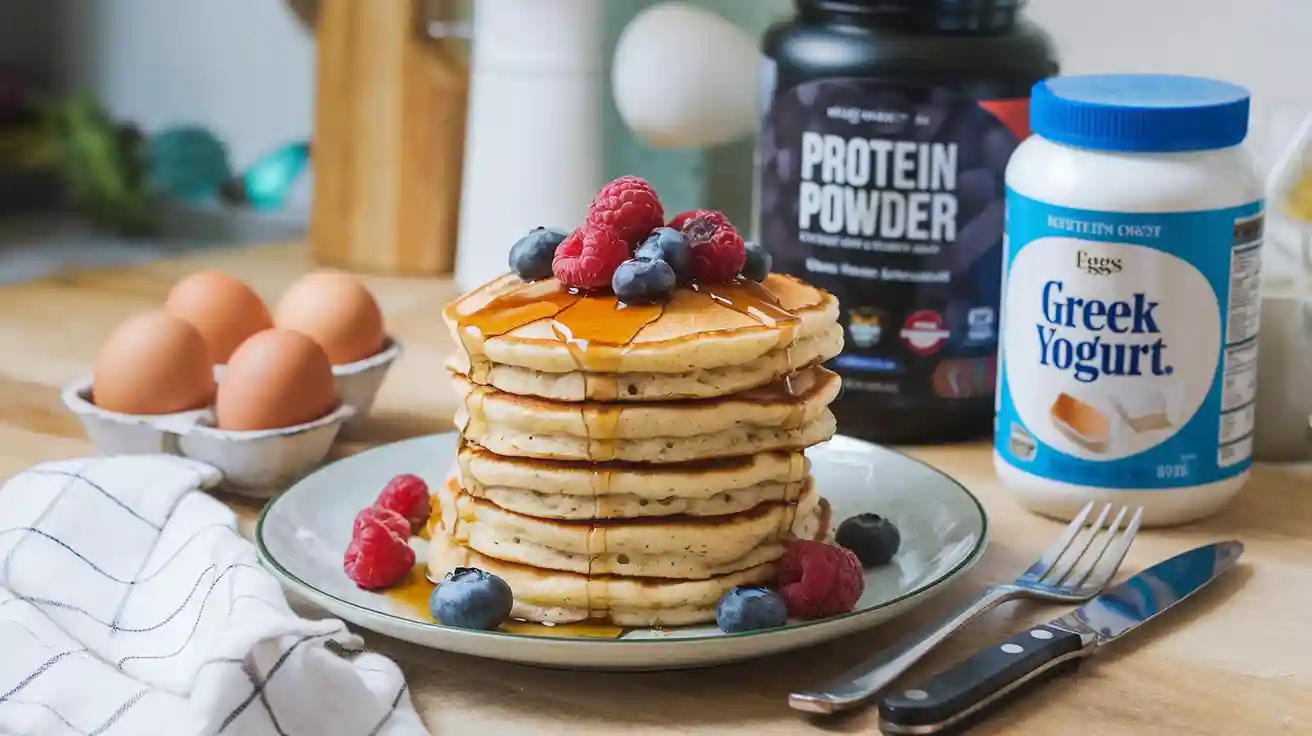Pancakes are a breakfast favorite, but have you ever wondered if you can turn this classic comfort food into a protein-packed powerhouse? The answer is a resounding yes! Adding protein to your pancake mix is a simple and effective way to boost your meal’s nutritional profile without sacrificing taste. In this guide, we’ll dive deep into the benefits, methods, and recipes for creating the ultimate protein pancakes.
Table of contents
- What Are Protein Pancakes? Discover Healthy Pancake Recipes for a Nutritious Start
- A Delicious Twist on Breakfast – Protein Pancakes That Support Muscle Growth and Repair
- Boost Your Meal with Protein for Muscle Growth and Repair
- Promotes Satiety
- Achieve Satiety and Stable Blood Sugar Levels with Protein-Infused Pancakes
- Versatile Options for Different Diets in Your Healthy Pancake Recipes
- The Benefits of Adding Protein to Pancakes for Healthier Pancake Recipes
- Enhanced Nutritional Value – Elevate Your Pancakes with Quality Protein
- Improved Satiety and Weight Management for Leaner Healthy Pancake Recipes
- Support Muscle Growth, Recovery, and Post-Workout Needs with Protein Pancakes
- Post-Workout Recovery
- Aiding Lean Muscle Development: A Key to Your Healthy Pancake Recipes
- High-Quality Protein Sources
- How to Add Protein to Your Pancake Mix: Tips for Crafting the Perfect Healthy Pancake Recipes
- Common Mistakes and How to Avoid Them
- Protein Pancake Recipe Ideas
- FAQs About Adding Protein to Pancakes
- Conclusion
What Are Protein Pancakes? Discover Healthy Pancake Recipes for a Nutritious Start
Protein pancakes are a healthier twist on traditional pancakes. They combine classic flavors with the added benefits of high-protein ingredients like whey protein powder, Greek yogurt, or almond flour. These pancakes support muscle recovery, satiety, and sustained energy.
For those who enjoy experimenting with nutritious ingredients, Buckwheat Flour Recipes You Need for Better Baking Today is a great resource to explore alternative flour options.
Protein pancakes are versatile and can be customized with various flavors, such as vanilla, chocolate, or berry, and can be topped with nutritious options like fresh fruits, nut butter, or seeds. Whether you’re preparing a post-workout breakfast or a healthy treat for the family, protein pancakes offer a guilt-free way to enjoy a classic comfort food.
A Delicious Twist on Breakfast – Protein Pancakes That Support Muscle Growth and Repair
Adding protein to your pancake mix enhances the nutritional value of this beloved breakfast staple, making it more than just a carb-heavy indulgence. Here’s why it’s a great idea.
Boost Your Meal with Protein for Muscle Growth and Repair
Protein is a crucial nutrient for building and repairing muscle tissue. By incorporating protein into your pancakes, you can create an excellent meal option for post-workout recovery or ongoing muscle maintenance. In addition, this simple adjustment can help support your fitness goals and overall strength.
Promotes Satiety
Moreover, protein helps you feel full for longer, reducing the likelihood of overeating or snacking between meals. As a result, protein pancakes provide a satisfying start to your day, helping you stay energized and focused on your tasks.
Achieve Satiety and Stable Blood Sugar Levels with Protein-Infused Pancakes
In contrast to traditional pancakes, combining protein with carbohydrates slows down the absorption of sugar into the bloodstream. Consequently, this leads to more stable blood sugar levels and prevents the energy crashes often associated with carb-heavy meals.
Versatile Options for Different Diets in Your Healthy Pancake Recipes
Another advantage of protein pancakes is their adaptability. Recipes can be customized for various dietary needs, including gluten-free, keto, or vegetarian diets. For instance, by using plant-based protein powders or almond flour, you can create pancakes that are both nutritious and suitable for a wide audience.
By enhancing your pancake mix with protein, you transform a traditional breakfast into a balanced, nutrient-packed meal that aligns with your fitness goals and lifestyle.
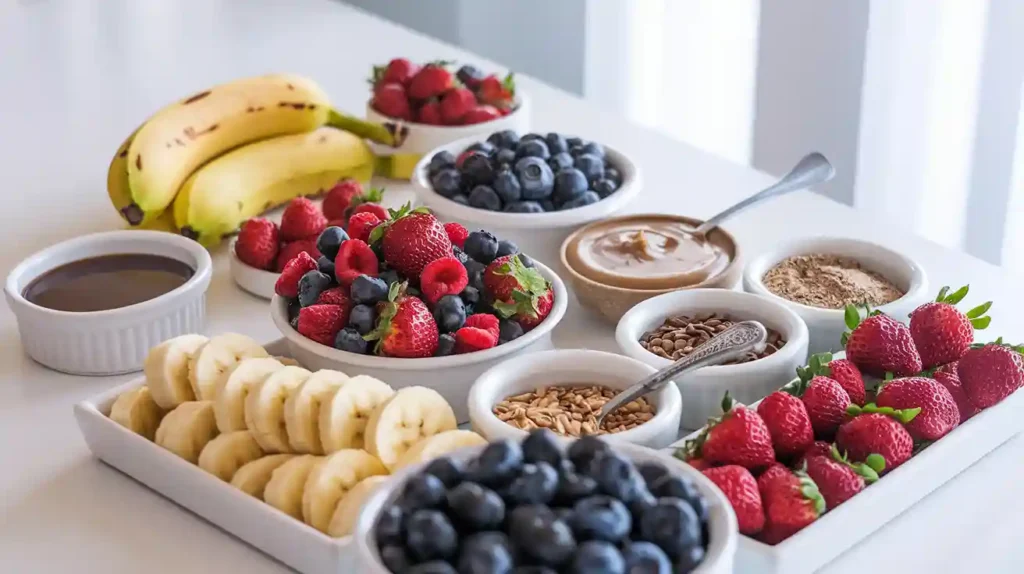
The Benefits of Adding Protein to Pancakes for Healthier Pancake Recipes
Enhanced Nutritional Value – Elevate Your Pancakes with Quality Protein
Adding protein to pancakes significantly boosts their nutritional profile, making them a healthier and more balanced meal choice. Here’s how the nutritional value is enhanced:
- Increased Protein Intake
By incorporating ingredients like protein powder, eggs, or Greek yogurt into the pancake mix, you elevate the protein content. This addition supports muscle growth, repair, and overall bodily functions that rely on adequate protein levels. - Balanced Macros
Traditional pancakes are primarily carbohydrate-heavy, which can lead to quick energy spikes and crashes. Adding protein balances the macronutrient ratio, providing sustained energy and reducing blood sugar fluctuations. - Essential Nutrients
Many protein sources, such as whey or plant-based powders, come enriched with additional nutrients like B vitamins, calcium, and iron. These nutrients contribute to better metabolic health, stronger bones, and improved immunity. - Reduced Caloric Density
Protein can help reduce the caloric density of pancakes by replacing some high-carb or fatty ingredients with leaner, more nutrient-rich options. This substitution makes protein pancakes a great choice for weight management. - Customization for Dietary Needs
Adding protein allows flexibility to cater to specific dietary goals or restrictions. For instance, using plant-based protein makes them vegan-friendly, while almond flour or coconut flour can accommodate gluten-free diets.
Incorporating protein into pancakes not only enhances their flavor but also transforms them into a nutritious powerhouse, perfect for fueling your body and supporting your health goals.
Improved Satiety and Weight Management for Leaner Healthy Pancake Recipes
Protein pancakes are excellent for promoting satiety, helping you feel full and satisfied for longer periods. This quality stems from the slower digestion and absorption rate of protein compared to carbohydrates. Here’s how this helps with weight management:
- Reduces Cravings
Starting your day with a high-protein meal can curb hunger hormones, minimizing mid-morning snack cravings or overeating at lunch. - Supports Caloric Control
The filling nature of protein reduces overall calorie intake without sacrificing satisfaction, making protein pancakes an ideal choice for those managing their weight. - Prevents Energy Crashes
Protein stabilizes blood sugar levels, preventing the highs and lows often associated with carb-heavy breakfasts. This leads to more consistent energy levels and reduces the urge to snack.
Support Muscle Growth, Recovery, and Post-Workout Needs with Protein Pancakes
Protein is essential for muscle repair and growth. As such, protein pancakes offer a convenient and delicious way to align with your fitness goals. Here’s why they’re highly effective:
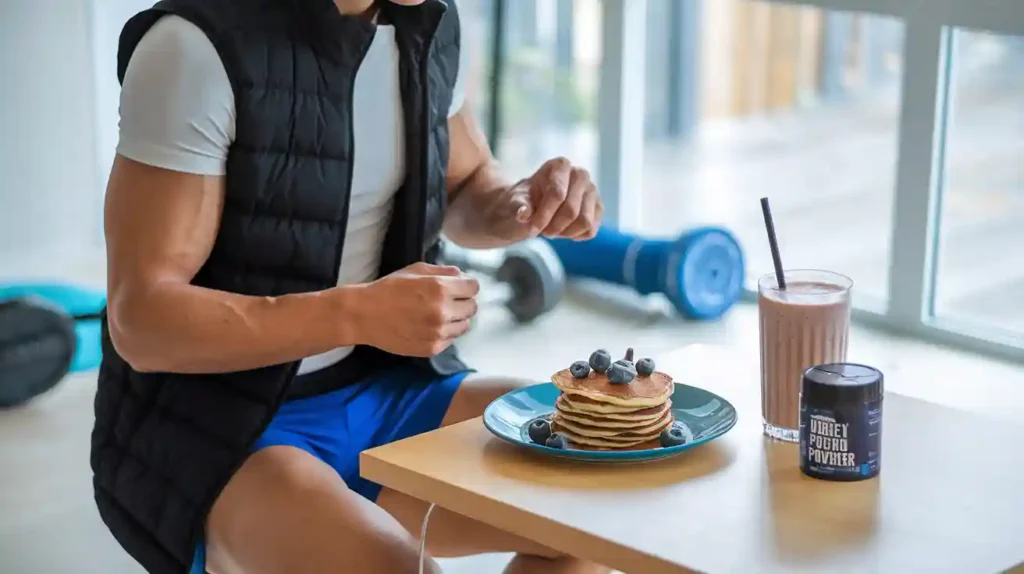
Post-Workout Recovery
First and foremost, consuming protein after exercise helps repair muscle fibers and encourages growth. Therefore, protein pancakes make an ideal post-workout meal, providing the nutrients needed for recovery.
Aiding Lean Muscle Development: A Key to Your Healthy Pancake Recipes
In addition, ensuring adequate protein intake supports the development of lean muscle mass. This not only improves strength but also boosts metabolism, helping you stay fit and active.
High-Quality Protein Sources
Furthermore, using high-quality protein ingredients such as whey or casein in your pancake mix ensures you receive essential amino acids. These amino acids are crucial for maintaining and optimizing muscle function, making your pancakes both tasty and effective.
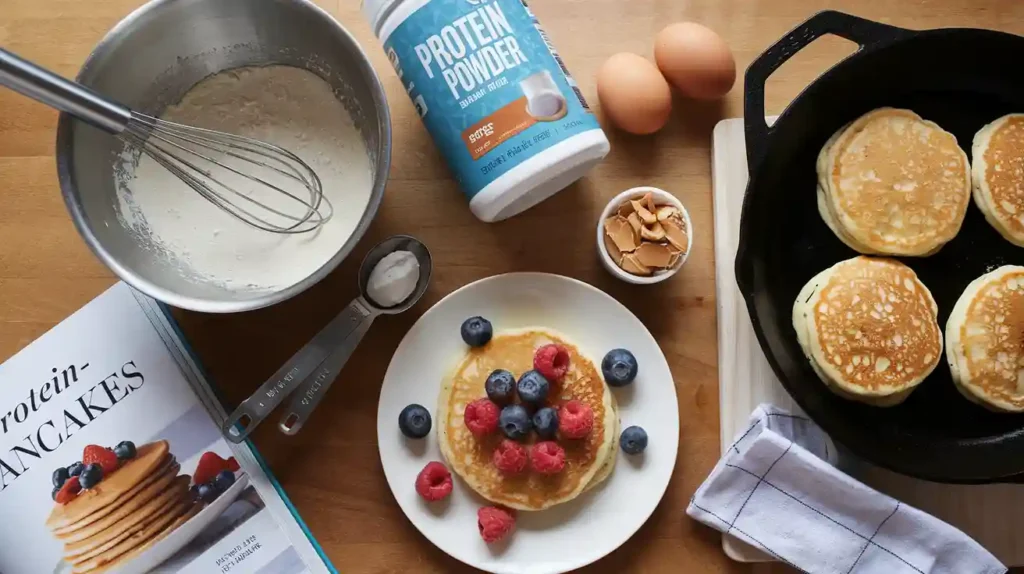
How to Add Protein to Your Pancake Mix: Tips for Crafting the Perfect Healthy Pancake Recipes
Protein Powder Options
- Whey Protein: A fast-digesting option for muscle recovery.
- Plant-Based Protein: Ideal for vegan or lactose-intolerant individuals.
- Collagen Protein: Supports skin and joint health without altering flavor.
Natural Protein Sources
- Greek Yogurt: Adds creaminess and protein.
- Egg Whites: A lean, dairy-free protein option.
- Almond Flour: Gluten-free and nutrient-rich.
Types of Protein Powders to Use
Whey protein is one of the most popular and widely used protein powders for good reason. Extracted from dairy, it is a complete protein, meaning it contains all nine essential amino acids. Here’s why it’s a great choice:
- Fast Digestion: Ideal for quick muscle recovery, making it perfect for post-workout pancakes.
- Light Texture: Adds fluffiness to pancakes without altering their traditional appeal.
- Rich in BCAAs: Contains branched-chain amino acids that support muscle repair and growth.
Plant-Based Proteins
Plant-based protein powders are a fantastic option for vegetarians, vegans, or those with lactose intolerance. Common sources include pea, hemp, brown rice, and soy protein. Key benefits include:
- Allergen-Friendly: Free from dairy, making it suitable for those with dietary restrictions.
- Nutrient-Rich: Often contains fiber and other nutrients that support digestion and overall health.
- Customizable Flavors: Available in natural, earthy flavors that pair well with other ingredients like bananas or cocoa.
Collagen Protein
Collagen protein powder is a unique addition to pancakes, focusing on benefits beyond muscle repair. It’s derived from animal connective tissues and is flavorless, which makes it versatile. Key advantages include:
- Joint and Skin Health: Supports joint mobility, skin elasticity, and overall wellness.
- Seamless Mixing: Blends easily into pancake batter without altering taste or texture.
- Low Allergen Risk: A non-dairy, non-plant-based option for those seeking a neutral supplement.
By choosing the right protein powder for your needs, you can tailor your protein pancakes to enhance flavor, nutrition, and dietary compatibility.
Common Mistakes and How to Avoid Them
Incorrect Consistency
Protein ingredients can affect the texture of your pancake batter, making it too thick, runny, or dense.
- Mistake: Overloading the batter with protein powder or failing to adjust liquid ratios.
- Solution: Start with small amounts of protein powder and gradually add liquid (milk or water) until you achieve a pourable consistency. Use eggs or Greek yogurt for added moisture.
Cooking Challenges
Protein pancakes can be tricky to cook, with issues like sticking, uneven cooking, or burning.
- Mistake: Cooking on high heat or failing to use a non-stick surface.
- Solution: Cook on medium-low heat and use a well-oiled non-stick pan or griddle. Be patient and wait for bubbles to form before flipping the pancakes.
Protein Pancake Recipe Ideas
Classic Vanilla Protein Pancakes
A simple, wholesome recipe perfect for any time of the day.
Ingredients:
- 1 scoop vanilla protein powder
- 1 cup oat flour
- 1 tsp baking powder
- 1 egg (or a flaxseed egg as a vegan alternative)
- ¾ cup milk (dairy or plant-based)
- 1 tsp vanilla extract
Instructions:
- Mix all dry ingredients in a bowl.
- Whisk wet ingredients separately, then combine with dry ingredients.
- Cook on a greased skillet over medium heat until golden on both sides.
- Serve with fresh berries and maple syrup.
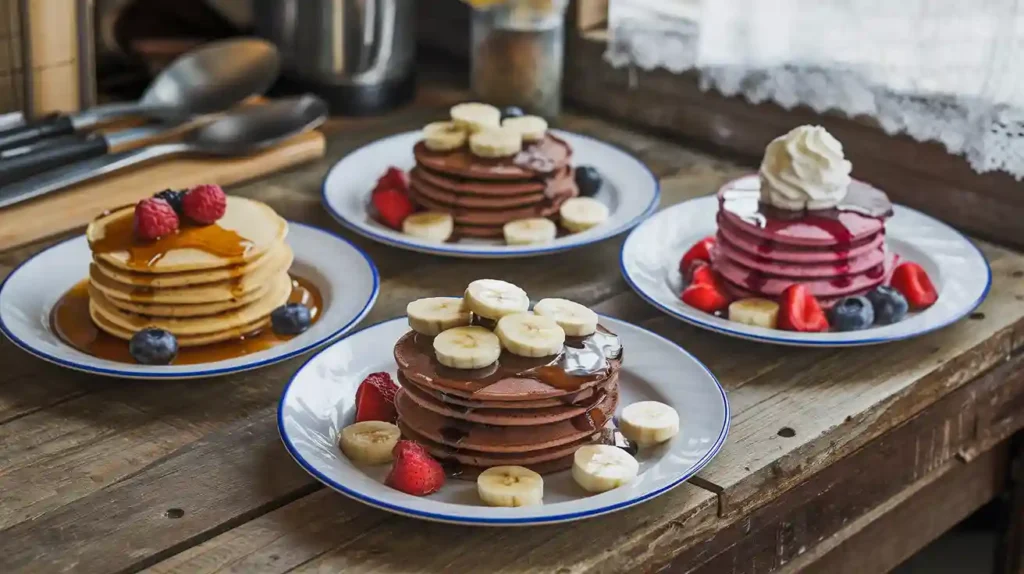
Chocolate Peanut Butter Protein Pancakes
A decadent, protein-rich treat for chocolate lovers.
Ingredients:
- 1 scoop chocolate protein powder
- ½ cup whole wheat flour
- 2 tbsp cocoa powder
- 1 egg
- 1 tbsp peanut butter
- ¾ cup milk (dairy or plant-based)
- 1 tsp baking powder
Instructions:
- Combine dry ingredients in a mixing bowl.
- In a separate bowl, whisk wet ingredients until smooth, then fold into the dry mix.
- Prepare pancakes on a greased skillet over medium heat.
- Top with sliced bananas, peanut butter drizzle, and chocolate chips.
Vegan Protein Pancakes
A plant-based option that’s high in protein and full of flavor.
Ingredients:
- 1 scoop plant-based protein powder (vanilla or unflavored)
- 1 cup almond flour
- 2 tbsp flaxseed meal (mixed with 5 tbsp water to create flax eggs)
- ¾ cup almond milk
- 1 tsp baking powder
- 1 tsp cinnamon (optional)
Instructions:
- Mix dry ingredients in a bowl.
- Add flax eggs and almond milk to the dry mix, stirring until a smooth batter forms.
- Cook the pancakes on a lightly greased skillet over medium heat.
- Garnish with coconut yogurt, berries, and a drizzle of maple syrup.
These recipes provide delicious and nutritious options for protein pancakes, tailored to a variety of tastes and dietary preferences!
FAQs About Adding Protein to Pancakes
Can I use flavored protein powder?
Yes, flavored protein powders are a great way to add variety and taste to your pancakes. Vanilla, chocolate, or even more exotic flavors like cinnamon roll or strawberry can complement your pancake mix. Just ensure the flavor aligns with your additional ingredients to avoid clashing tastes. Start with a small amount to ensure the flavor isn’t overpowering.
Will protein powder change the texture?
Yes, protein powder can alter the texture of pancakes, often making them denser or slightly drier than traditional pancakes. To maintain a fluffy consistency, balance the recipe with moist ingredients like eggs, Greek yogurt, or mashed bananas. Adjust the liquid content to achieve a pourable batter.
What are the best toppings for protein pancakes?
The best toppings are both delicious and nutritious, such as:
- Fresh fruits (berries, bananas, or apples)
- Nut butters (almond, peanut, or cashew butter)
- Yogurt (Greek or plant-based for extra protein)
- Nuts and seeds (chia, flax, or sunflower seeds)
- Maple syrup, honey, or a drizzle of dark chocolate for sweetness.
Can I make protein pancakes gluten-free?
Absolutely! Use gluten-free alternatives like almond flour, oat flour (certified gluten-free), or quinoa flour. Pair these with a gluten-free protein powder and ensure other ingredients, like baking powder, are also certified gluten-free.
Are protein pancakes suitable for kids?
Yes, protein pancakes are a healthy and kid-friendly option, as long as the protein powder or other ingredients are age-appropriate. Use natural, minimally processed protein sources like Greek yogurt, eggs, or plant-based options to suit their dietary needs. Avoid overly sweetened or artificially flavored powders for children.
How many pancakes can I eat per serving?
The number of pancakes per serving depends on your nutritional goals and portion sizes. For most adults, 2–3 medium-sized protein pancakes provide a balanced meal, delivering enough protein, carbohydrates, and fats. Adjust serving sizes for kids or smaller appetites accordingly. Always consider the overall calorie and macronutrient content of your recipe.
These FAQs address common concerns and provide practical tips for creating and enjoying protein pancakes to suit your preferences and dietary needs!
Conclusion
Protein pancakes are a versatile and nutritious alternative to traditional pancakes. Not only do they make an excellent choice for boosting protein intake, but they also allow you to enjoy a delicious meal. By incorporating high-quality protein sources such as whey, plant-based powders, or natural alternatives like eggs and Greek yogurt, you can easily transform pancakes into a balanced and satisfying dish. As a result, this aligns perfectly with your health and fitness goals.
Furthermore, whether you’re aiming for improved satiety, muscle recovery, or simply a healthier breakfast option, protein pancakes cater to a wide range of dietary needs and preferences. They are adaptable, making them suitable for different lifestyles, from fitness enthusiasts to families seeking nutritious meal ideas. In addition, their versatility means you can customize them with various flavors and toppings to keep your meals exciting and wholesome.
With a variety of flavors, toppings, and recipes available, they offer endless possibilities to keep your meals exciting and wholesome.
By avoiding common mistakes, customizing your ingredients, and exploring creative recipes, you can easily make protein pancakes a staple in your routine. Start experimenting today and enjoy a perfect combination of taste and nutrition with every bite!

